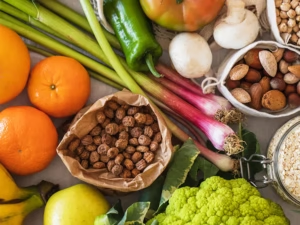Introduction
Fiber is one of the most important components of a balanced diet for many individuals who fall short of their daily requirements. High-fiber foods ensure digestive health, minimize the risk of chronic diseases, and support well-being generally. In this article, we discuss the benefits of high-fiber food, the best sources of dietary fiber, and how to include more of them in your diet. Finally, we answer five frequently asked questions about fiber and its importance.
Fiber is a type of carbohydrate that the body can’t digest. Unlike other nutrients, the majority of fiber passes through the digestive system relatively unchanged. There are two basic categories of fiber:
Soluble Fiber: It dissolves in water to create a gel-like paste; helps to lower cholesterol and regulate blood sugar levels.
Insoluble Fiber: Adds bulk to stool, which supports regular bowel movements and prevents constipation.
Benefits of High-Fiber Foods
1. Promotes Healthy Digestion
Fiber maintains regular bowel movements and prevents constipation by adding bulk to stool. Specifically, insoluble fiber facilitates the way food moves through the digestive tract.
2. Lowers Chronic Disease Risk
Eating high-fiber foods can lower your risk for a number of chronic diseases, such as:
Heart Disease: Soluble fiber helps reduce LDL (bad) cholesterol levels.
Type 2 Diabetes: Fiber slows down the absorption of glucose, thereby helping to regulate blood sugar levels.
Colon Cancer: Fiber-rich diets are related to a reduced risk of colorectal cancer.
3. It helps in Weight Management
High-fiber foods are satiating and promote a feeling of fullness, which can prevent overeating, thus aiding in weight reduction or maintaining one’s weight.
4. Aids in Gut Health
Some dietary fiber is food to the good gut bacteria, helping keep your gut microbiome healthy. This improves digestive and immune systems while enhancing overall health.
Best High-Fiber Foods

Mixing different high-fiber foods in your diet ensures you get both soluble and insoluble fiber. Here’s a list of great sources of dietary fiber:
1. Fruits
Apples (with skin): 4 grams per medium apple
Pears (with skin): 6 grams per medium pear
Raspberries: 8 grams per cup
Bananas: 3 grams per medium-sized banana
2. Vegetables
Broccoli: 5 grams per cup, cooked
Brussels sprouts: 4 grams per cup, cooked
Carrots: 3.6 grams per cup, raw
Spinach: 4 grams per cup, cooked
3. Legumes
Lentils: 15 grams per cup, cooked
Black beans: 15 grams per cup, cooked
Chickpeas: 12 grams per cup, cooked
Split peas: 16 grams per cup, cooked
4. Whole Grains
Oats: 4 grams per cup, cooked
Quinoa: 5 grams per cup, cooked
Brown rice: 3.5 grams per cup, cooked
Whole wheat bread: 2 grams per slice
5. Nuts and Seeds
Chia seeds: 10 grams per ounce
Flaxseeds: 8 grams per ounce
Almonds: 3.5 grams per ounce
Sunflower seeds: 3 grams per ounce
Daily Fiber Recommendations
Habit for Processed Foods:
Change from low-fiber, processed foods to whole fiber-rich foods can be really difficult. Therefore, make changes one meal/snack at a time.
Conclusion
High-fiber foods are a basic part of a healthy, balanced diet. It aids in digestive health, decreases the risk of chronic diseases, aids in weight management, and enhances overall well-being. You can easily meet your daily fiber requirements by including a variety of fiber-rich fruits, vegetables, whole grains, legumes, nuts, and seeds in your diet. Make small and consistent changes today to reap the lifelong benefits of a high-fiber diet.
FAQs
Q1: Is it unsafe to consume excess fiber?
A: High levels of fiber in the diet greater than 70 grams per day may lead to digestive problems such as bloating, gas, and diarrhea. The bottom line-balance is crucial. Gradually build up fiber intake and drink plenty of water.
Q2: What is soluble and insoluble fiber?
A: Soluble fiber dissolves in water and becomes a gel, lowering cholesterol levels and helping stabilize blood sugar. Insoluble fiber does not dissolve, adds bulk to stool, and aids in regular bowel movements.
Q3: Can fiber supplements replace dietary fiber?
A: Supplements can supplement, but the client should be encouraged to get their fiber from high-fiber foods which provide other nutrients and benefits.
Q4: Do patients have specific medical conditions that require a low-fiber diet?
A: Certain medical conditions for digestive disorders, such as Crohn’s disease or ulcerative colitis, may require a very short-term low-fiber diet during recovery from surgery. Consult a health care provider.
Q5: Should children require as many dietary fiber ounces as adults?
A: Kids require less fiber than adults. The rule of thumb is to add 5 to their age (a 10-year-old should aim for about 15 grams of fiber per day).